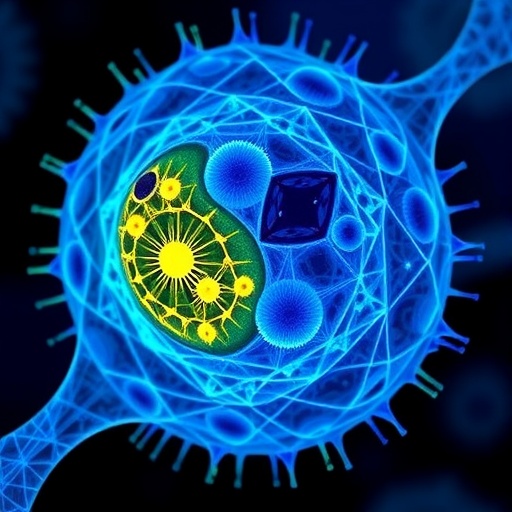In the intricate world of cellular biology, the compact structure of human DNA presents both a marvel and a challenge. Approximately 20,000 genes are meticulously coiled within a two-meter-long DNA strand, all integrated within a nucleus that spans merely 10 micrometers in diameter. To visualize this, consider a 40-kilometer thread crammed into a soccer ball—this analogy emphasizes the remarkable organization required for such a complex system to function effectively. Within this tightly knit environment, stem cells exhibit an extraordinary ability to swiftly locate and activate specific genes, a feat accomplished in mere minutes. However, the selection of these genes varies significantly from one cell type to another, making the precision of gene activation crucial. Erroneous gene selection can lead to dire consequences, including disease onset or cell death, underscoring the complexity of cellular operations.
Recent investigations conducted by researchers from the Karlsruhe Institute of Technology (KIT) have unveiled the vital role of biomolecular condensates in the rapid and reliable activation of the appropriate genes within the cell nucleus. Professor Lennart Hilbert, from the Institute of Biological and Chemical Systems at KIT, elucidates this process by likening biomolecular condensates to tiny droplets that form at specific loci on DNA, reminiscent of condensation on a bathroom mirror after a hot shower. These condensates, akin to oil droplets within water, play a critical role in organizing and activating gene expression by harboring molecular machines—combinations of specific molecules essential for gene activation. This elegant system draws parallels to a key concept in computer science, the von Neumann architecture, wherein a single processor accesses a memory address swiftly. This innovative research aims to translate these biological principles into artificial, DNA-based computer chips, with potential ramifications in biotechnology and biomedicine.
The ambition of the KIT researchers extends beyond mere understanding; they aspire to replicate the functionality of biomolecular condensates to construct artificial DNA nanostructures, envisioned as integral components of computer chips. This goal meshes traditional laboratory experiments with cutting-edge computer simulations, enabling a comprehensive understanding of the behavior of these condensates. Mona Wellhäusser, a doctoral researcher at IBCS and a co-author of the research, emphasizes the utility of digital models to predict and comprehend the behavior of DNA nanostructures. By simulating systems in which enzymes operate like miniature machines, performing specific calculations and tasks, researchers can direct these enzymes to their target locations on DNA through a process known as surface condensation. This approach facilitates the autonomous accumulation of enzymes precisely where they are needed, streamlining the research process.
The efficiency gained through computer simulations is notable. They significantly reduce the time required for research compared to traditional laboratory experiments, which are often time-consuming and resource-intensive. Hilbert remarks on the efficiency of this methodology, stating that through their research, scientists are crafting pathways for developing a more expansive and intricate address system for DNA-based computing. The implications of this work are Earth-shattering; it may pave the way for entirely new DNA-based storage and computing systems that mimic the architectural elegance observed in nature.
The application of this research extends into real-world scenarios, evidenced by the success of COVID-19 mRNA vaccines and personalized “programmed” gene therapies. Such breakthroughs illustrate the immense potential of biotechnologies programmed by DNA and RNA. The research team at KIT also foresees promising applications in the development of “DNA chips”, which could revolutionize cancer therapy. By modifying immune cells to activate upon encountering cancer cells, these chips could represent a significant leap forward in smart therapeutic interventions.
Furthermore, the work of the KIT researchers serves to elevate our understanding of genetic regulation. Recognizing how biomolecular condensates operate offers invaluable insights into the mechanisms underpinning gene expression and regulation. As the scientific community increasingly turns its gaze towards these molecular phenomena, the potential applications in biotechnology will likely expand, influencing everything from therapeutic strategies to the creation of novel bio-computational devices.
The groundbreaking findings from the KIT team illustrate the fusion of biology and technology, signifying a new era in genetic research and its application. By harnessing nature’s sophisticated systems and integrating them into the realm of computing, this research not only sets the stage for advancements in disease treatment but also propels us towards a future where biological systems could intertwine seamlessly with technological innovation. The comprehensiveness of these explorations indicates the endless possibilities that lie ahead, expanding our toolkit for understanding and manipulating the biological world.
As we navigate this new frontier of DNA-based technologies, the implications are profound. The work being done today could dictate the trajectory of therapeutic development for generations. It emphasizes the necessity for interdisciplinary collaboration, where biology, computer science, and engineering converge to solve some of the most pressing challenges in healthcare and beyond. Each step forward represents not only a deeper understanding of life at the molecular level but also an opportunity to reshape how we approach problem-solving in the context of health and technology.
In conclusion, the integration of findings related to biomolecular condensates and DNA nanostructures may well revolutionize our approach to computing and biotechnology. As these researchers from KIT continue to unravel the complexities of gene activation and regulation, they embark on a path that could yield unprecedented tools and therapies, changing the face of biotechnology and life sciences as we know it.
Subject of Research: Cells
Article Title: Chromatin-associated condensates as an inspiration for the system architecture of future DNA computers
News Publication Date: 5-Sep-2025
Web References: DOI: 10.1111/nyas.15415
References: None available
Image Credits: Photo: Lennart Hilbert, KIT




